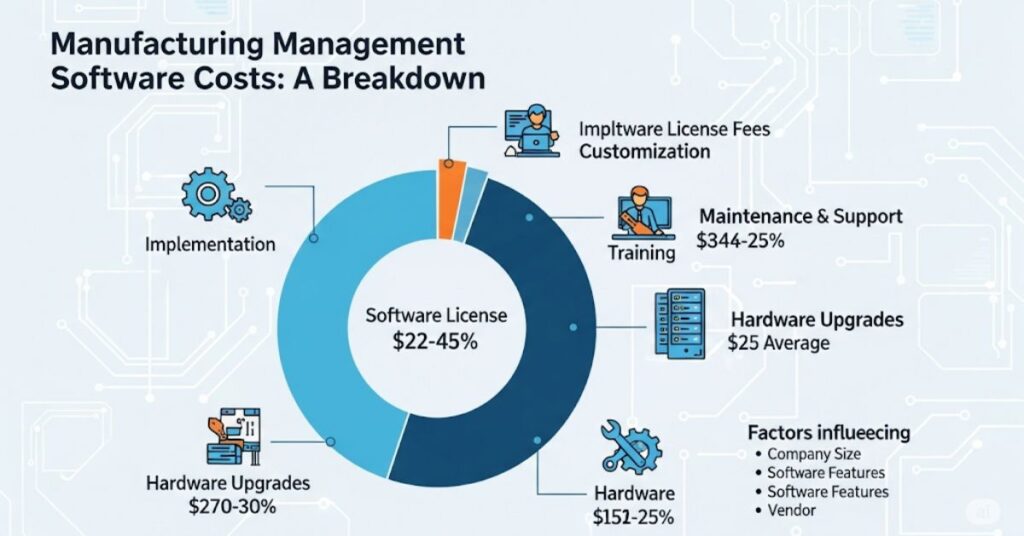Manufacturing software, often referred to as Manufacturing Execution System (MES) or the integrated manufacturing Enterprise Resource Planning (ERP) software is critical to improving manufacturing operations and inventory control to maintain high quality production. The advantages of having a manufacturing management software in uae are easily ascertainable; however, its expenses can be very different depending on several parameters. In this guide we will look at the mainly significant cost factors, the various cost structures likely to be encountered depending on the size of the manufacturing firm, the degree of customization, and the implementation needs.
1. Comprehension of Manufacture Management software
Manufacturing management software refers to a program that assists in managing different sections of manufacturing such as production planning, material control, quality assurance and many more. There are many options that a modern company can implement from single solutions for small companies to large full-scale ERP solutions designed to manage every aspect of manufacturing.
2. Factors that determine the cost of manufacturing management software.
There are a number of influences which relate to the cost of manufacturing software. The key elements to consider are:
a. Deployment Model
• Cloud-Based:
Typically, cloud-based systems have the problem of high acquisition cost but their maintenance costs are low and are based on subscription. They are best suited where the company wishes to grow in the near future and desires to cut down the initial cost.
• On-Premises:
The initial costs that come with on-premises are costs in license for the software and costs in setting up hardware which are quite high, however if you refrain from incurring these constant costs with cloud solutions then on-premises deployments could prove to be cheaper in the long run.
b. Licensing Model
• Subscription-Based:
A majority of cloud service providers have yearly or monthly plans which while might be constant can add up over the entire year.
• Perpetual License:
On-premises solutions are typically licensed for a single fee and businesses using them may require them for many years without having to pay any more license fees.
c. Number of Users and Scale
Some companies may require only a couple of user licenses, while others, such as large manufacturing corporations, will need user licenses for hundreds of their employees in various organizational units. Based on the above conclusions, price differentiation has a tremendous influence on the total cost, with a focus on user-based schemes.
d. Integration with Existing Systems
Integrating manufacturing management software with other business systems, such as supply chain, accounting, or custom erp software in uae, can drive up costs due to the need for specialized development and data migration.
e. Training and Support
Training employees to effectively use new software is crucial, and many vendors offer training packages. Service packages which are usually paid on an annual or monthly basis guarantees a client the service whenever they encounter a problem.
f. Training and Support
Training employees to effectively use new software is crucial, and many vendors offer training packages. Ongoing support packages, usually charged as an annual or monthly fee, ensure access to assistance when issues arise.
3. The Pricing Strategies of Manufacturing Management Software
Software providers offer several pricing models, each with its pros and cons:
a. Subscription Model
• Monthly or Annual Fees:
SaaS based models are normally implemented with monthly or annual contracts pegged on the number of users or data volume sought. Monthly subscriptions depend on the software’s functionality and parking at $50 to $500 per user.
b. Perpetual License Model
• One-Time Fees:
On-premises solutions typically have a license cost that is paid once for each instance, and ranges from $10, 000 to more than $ 100, 000 depending on the system size and the degree of customization.
C. Pay-Per-Feature Model
• Module-Based Pricing:
Some vendors have developed modular pricing strategies that mean that customers only pay for the features that they require initially, but have the flexibility to purchase additional modules as their businesses expand: essentially, the basic set of features would be suitable for smaller enterprises, with the ability to add modules as required in future.
D. Usage-Based Pricing
• Usage Fees:
Some software costs depend on data volume or computing capacity, so this will fit into the picture for businesses with fluctuating production cycles.
Conclusion
The cost of manufacturing management software depends on the deployment, customization, and the needs that your manufacturing business has. The present study demonstrates how factors affecting cost, comparisons of different pricing strategies, and assessment of potential ROI can assist the manufacturers in making better decisions when setting their affairs and achieving more within the constraints of available funds. For a small company that seeks to purchase a simple solution, to a large company that needs a more sophisticated system, the implementation of the right manufacturing management software is likely to pay big dividends in terms of improved efficiency and profitability.


